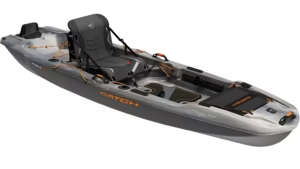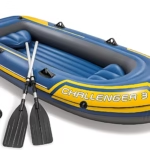For ocean use, the best sit-on-top kayaks include the Ocean Kayak Prowler, Perception Pescador, and Wilderness Systems Tarpon. These kayaks offer stability, durability, and performance in open waters.
Sit-on-top kayaks are popular for ocean adventures due to their stability and ease of use. They are designed to handle waves and currents, making them ideal for ocean paddling. The Ocean Kayak Prowler is known for its speed and tracking, while the Perception Pescador offers excellent stability and storage options.
The Wilderness Systems Tarpon is a versatile kayak that performs well in various ocean conditions. Whether you’re fishing, touring, or just exploring, these kayaks provide a reliable and enjoyable experience on the water.

Top Features To Look For
Selecting the best sit-on-top kayak for ocean use requires knowing key features. These features ensure safety, performance, and enjoyment on the water. Here are the top features to keep in mind.
Hull Design
The hull design is crucial for ocean kayaking. A well-designed hull provides stability and speed. Look for a V-shaped hull for better tracking. This design cuts through waves smoothly.
A flat hull offers stability but less speed. Choose based on your needs. For rough seas, a V-shaped hull is better.
Material And Durability
The material of the kayak affects its durability. Most ocean kayaks are made from polyethylene. This material is durable and affordable.
For a lightweight option, consider fiberglass or composite. These materials are strong but may cost more. Always check the material’s resistance to UV rays and saltwater corrosion.
Storage Options
Storage is vital for long ocean trips. Many kayaks offer different storage options. Check for dry storage compartments to keep your gear safe and dry.
Some kayaks come with bungee storage areas on the deck. These are great for easy access to items. Ensure the kayak has enough storage for your needs.
| Feature | Importance | Details |
|---|---|---|
| Hull Design | High | V-shaped for speed, flat for stability |
| Material | High | Polyethylene, fiberglass, composite |
| Storage | Moderate | Dry compartments, bungee storage |
Safety Considerations
When paddling a sit-on-top kayak in the ocean, staying safe is crucial. The sea can be unpredictable, and your kayak should be prepared for it. Here we discuss key safety considerations to keep you safe on the water.
Stability
Stability is vital for ocean kayaking. A stable kayak reduces the risk of capsizing. Look for kayaks with wider hulls. They offer more stability in choppy waters. A wider hull also makes it easier to balance. This is especially important for beginners.
Self-rescue Techniques
Knowing how to get back on your kayak is essential. Practice self-rescue techniques before heading out. You should know how to re-enter the kayak from the water. This skill can save your life if you fall in. It’s also helpful to learn the paddle float rescue method. A paddle float can assist in stabilizing the kayak during re-entry.
Essential Safety Gear
Always carry the right safety gear. Here’s a list of essential items:
- Personal Flotation Device (PFD): Always wear a PFD. It can save your life.
- Whistle: A whistle helps you signal for help.
- Paddle Leash: A paddle leash keeps your paddle attached to the kayak.
- Bilge Pump: A bilge pump helps remove water from the kayak.
- First Aid Kit: Always have a first aid kit on board.
- Marine Radio: A marine radio allows you to communicate in emergencies.
Having the right gear ensures you are prepared for any situation. Make sure all equipment is in good condition before you set out. Safety should always be your top priority.
Best Sit-on-top Kayaks For Beginners
Starting with kayaking can be fun and exciting. Beginners need kayaks that are easy to use and stable. Sit-on-top kayaks are perfect for this. They offer great balance and are user-friendly.
Ease Of Use
Sit-on-top kayaks are designed for easy entry and exit. They are stable and safe, even in ocean waters. Beginners find them less intimidating. These kayaks are also self-bailing. This means water drains out quickly, keeping you dry.
Top Picks For Starters
| Kayak Model | Length | Weight Capacity | Features |
|---|---|---|---|
| Pelican Sentinel 100X | 9.5 feet | 275 lbs | Lightweight, Comfortable seat |
| Ocean Kayak Malibu Two | 12 feet | 425 lbs | Tandem, Versatile |
| Perception Tribe 9.5 | 9.5 feet | 300 lbs | Durable, Easy to maneuver |
These models are highly recommended for new kayakers. They are stable, easy to paddle, and affordable.
- Pelican Sentinel 100X: Lightweight and easy to transport.
- Ocean Kayak Malibu Two: Great for families or tandem kayaking.
- Perception Tribe 9.5: Durable and user-friendly.
These kayaks help beginners gain confidence on the water. They offer a smooth and enjoyable experience.
Best Sit-on-top Kayaks For Advanced Users
Advanced kayakers need specialized equipment to conquer ocean waves. Sit-on-top kayaks offer great performance. Here, we explore the best options for experienced users.
Performance Features
Advanced sit-on-top kayaks have unique features. These features ensure superior performance in the ocean:
- Hull Design: Sleek and streamlined for speed.
- Material: Lightweight but durable for rough waters.
- Stability: High stability to handle ocean swells.
- Storage: Plenty of storage for long trips.
- Comfort: Ergonomic seating for long hours.
Top Picks For Experts
Here are the top sit-on-top kayaks suited for advanced users:
| Kayak Model | Performance Features | Price Range |
|---|---|---|
| Ocean Kayak Trident 15 |
|
$1,000 – $1,500 |
| Perception Pescador Pro 12 |
|
$800 – $1,200 |
| Hobie Mirage Outback |
|
$2,000 – $2,500 |
Accessories To Enhance Your Experience
Exploring the ocean with a sit-on-top kayak can be thrilling. To make your adventure safe and fun, you need the right accessories. These tools can make paddling easier and your trip more enjoyable. Let’s dive into some must-have accessories for ocean kayaking.
Paddles And Leashes
Choosing the right paddle is crucial. A lightweight paddle reduces fatigue. Look for paddles made from carbon fiber or fiberglass. These materials are strong and light.
Another essential accessory is a leash. A paddle leash secures your paddle to your kayak. If a wave knocks your paddle away, the leash keeps it close. This simple tool can save your trip and keep you safe.
| Accessory | Benefit |
|---|---|
| Lightweight Paddle | Reduces fatigue during long trips |
| Paddle Leash | Keeps your paddle secure in rough waters |
Comfort Enhancements
Comfort is key for long kayaking trips. A padded seat can make a big difference. Look for seats with adjustable backrests and cushioned padding.
Foot braces are another great addition. They provide support and help you paddle more efficiently. Adjustable foot braces can fit any paddler’s height.
- Padded Seat: Ensures comfort for hours of paddling.
- Adjustable Foot Braces: Provides support and improves paddling efficiency.
Storage Solutions
Having enough storage is vital for ocean kayaking. Dry bags and waterproof containers keep your gear safe and dry.
Kayak storage hatches offer secure places for your belongings. Choose kayaks with multiple hatches for better organization.
- Dry Bags: Protect valuables from water damage.
- Waterproof Containers: Ideal for electronics and food.
- Storage Hatches: Keep gear organized and secure.
With these accessories, your ocean kayaking experience will be safer and more enjoyable. Equip your kayak properly and enjoy the waves!
Maintenance Tips
Maintaining your sit-on-top kayak is crucial for its longevity. Follow these tips to ensure your kayak stays in top condition for many ocean adventures.
Cleaning And Storage
Cleaning your kayak after each use is essential. Saltwater can cause damage over time. Rinse the kayak with fresh water to remove any salt, sand, or debris. Use a mild soap if necessary.
- Use a soft cloth to scrub the surfaces gently.
- Pay attention to the crevices and hard-to-reach areas.
Proper storage is equally important. Store your kayak in a cool, dry place away from direct sunlight. Prolonged exposure to UV rays can weaken the material.
- Store the kayak on a rack or padded surface.
- Keep it upside down to prevent deformation.
Routine Inspections
Regular inspections help identify issues early. Check for cracks, holes, or any structural damage. Inspect the hull, deck, and cockpit for signs of wear.
| Inspection Area | What to Look For |
|---|---|
| Hull | Cracks, dents, and scratches |
| Deck | Loose fittings, cracks |
| Cockpit | Wear and tear, loose parts |
Check the kayak’s hardware, such as screws, handles, and footrests. Make sure they are secure and in good condition. Replace any damaged parts to ensure safety.
- Inspect the hardware for rust or damage.
- Tighten any loose screws or fittings.
- Replace worn-out parts promptly.
Frequently Asked Questions
What Makes A Kayak Suitable For Ocean Use?
A kayak suitable for ocean use should be stable and durable. It should have features like self-bailing scupper holes. It must also be UV resistant and have ample storage for safety gear.
Are Sit-on-top Kayaks Good For Beginners?
Yes, sit-on-top kayaks are excellent for beginners. They are stable and easy to get in and out of. These kayaks are also user-friendly and comfortable for extended use.
How Should I Maintain My Ocean Kayak?
Rinse your ocean kayak with fresh water after each use. Store it in a cool, dry place away from direct sunlight. Inspect and repair any damage immediately to ensure longevity.
What Safety Gear Do I Need For Ocean Kayaking?
Essential safety gear includes a life jacket, whistle, and paddle leash. A bilge pump and first aid kit are also recommended. Always carry a communication device for emergencies.
Conclusion
Choosing the best sit-on-top kayak for ocean use enhances your adventure. Prioritize stability, durability, and comfort. Explore various models to find your perfect match. Investing in a quality kayak ensures safe and enjoyable ocean trips. Happy kayaking and may your ocean adventures be unforgettable!




